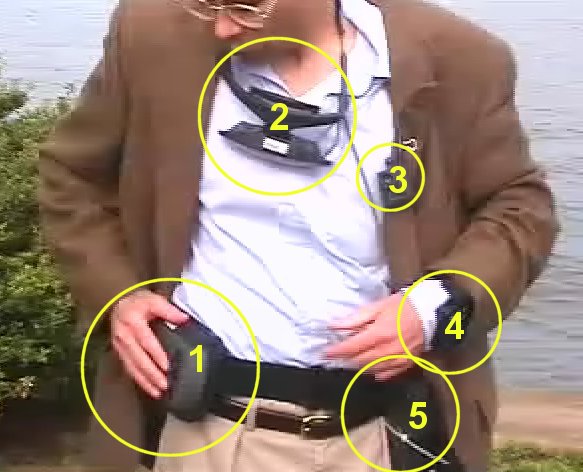
The focus of this project is to create an anybody, anyplace, anytime, anything (digital) educational environment. Students don a wearable computer connected through the internet using a wireless transceiver. They may communicate using traditional means such as e-mail or via a text chat or verbal chat facility such as Excite Voice Chat. Or they may enter into a shared virtual reality (VR) environment with other avatars such as in Activeworlds (AW). In AW they can share real time images visible from their head mounted cameras, or they can move from one VR world to another to explore ocean bottoms or outer space.
The Gartner group, a leader in the dissemination of information about information technology stated in 1999 that wearable computing was one of the top 10 technologies to watch in the coming decade. Again with the help of Sam Rastin, one of our graduate research assistants, we are positioning our role in the demonstration and use of this technology as the new media for delivery of education - expertise just in time. The shot below shows the technology components for this environment - as a 21st Century platform for projecting learning into the field - technology supported learning by doing.

1. Central Processing Unit - this "all in one" unit, from Xyber naut
Corporation, contains a 266 MHz Pentium II computer with 128 MB RAM, a
4.3 GB hard drive, a double wide PCMCIA slot, a USB port, and a mouse.
Cost - approx
2. Heads-Up Display - these glasses, from Sony Corporation provide
a screen, equivalent to a 60 inch diagonal monitor. Cost - approx $1800.
3. Video Camera - comes with CPU
4. Wrist Keyboard - cost approx $150
5. Battery Pack - comes with basic unit
6. Missing from view is our Ricochet wireless modem from Metricom Corporation.
approx $300 initial cost + $30/month service.
While in major metropolitan areas of the United States, the user of this wearable can be connected to the internet for performing "full bore" computing tasks whether it be data base access and update, videoteleconferencing, or web surfing. This computing machine is not a limited capacity device such as a Personal Digital Assistant (PDA). It has fully functional capability - equivalent to a desktop computer.
We have now connected 3 of these units together in an "untethered" network. Use of collaborating units such as these completely changes the meaning and scope of computing. While uses of wearables now are largely operational, that is for field tasks such as installation and maintenance, this device provides a method for moving far beyond the traditional "seated" classroom. Educators need to begin to re-think the locus and operandi of the educational forum. Why a physical classroom? Why books? Why do all student need to be present simultaneously? What is the new paradigm for "classroom" learning?
If the college Freshman English class is on Shakespeare, why not visit the Globe Theatre as it existed in the 1600's - in virtual reality, while sitting under an oak tree in the school's quad.Thinking through this capability requires considerable thought, and a willingness to break the paradigm we have been exposed to since early childhood - the physical classroom. But the capability now available by combining the best of IT - simulation, virtual reality and untethered high quality communication provides a mechanism for superceding a aged paradigm and for increasing and accelerating learning.If the class is on politics, why not pull up the legislative history of the subject under discussion [on the wearable's screen], while sitting in the gallery of the state legislative building as you listen to the arguments of the legislators?
If the third year medical school class is on 'rounds' and encounters a patient with a brain hematoma, why not bring up a magnetic resonance image scan of the patient's brain overlayed on the patient as he is being examined.
If the class is on data networks, why not bring up the ISO level 1 schema on the wearable screen while viewing the physical wiring in the control room.
| What they wear.
|
What they see.
|